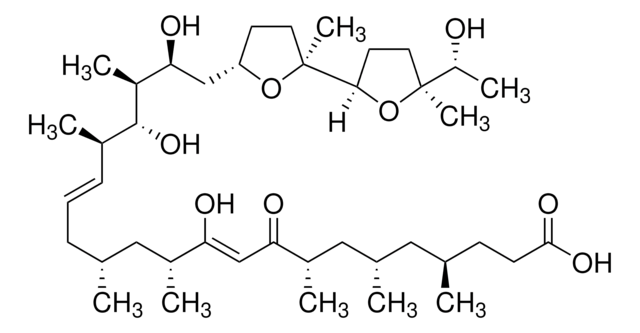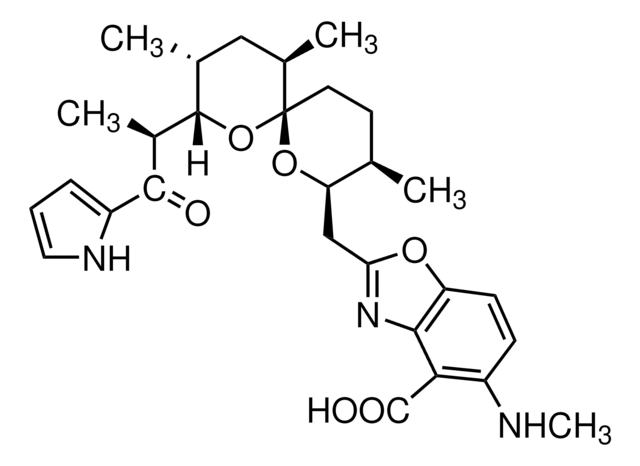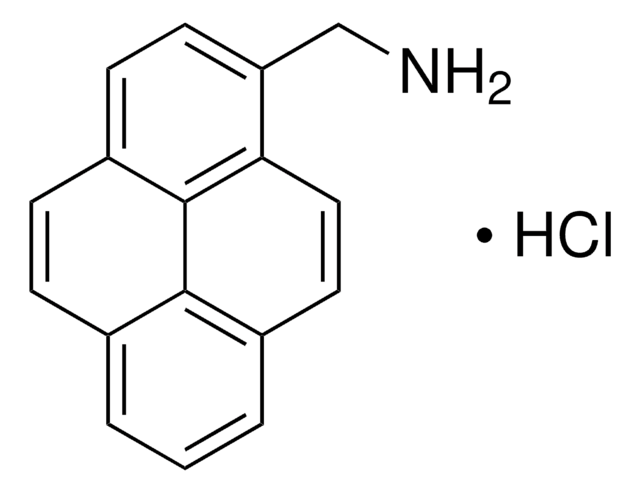79346
Phorbol 12-myristate 13-acétate
synthetic, ≥98.0% (TLC)
Synonyme(s) :
12-O-Tétradécanoylphorbol 13-acétate, 4β,9α,12β,13α,20-Pentahydroxytiglia-1,6-dièn-3-one 12-tétradécanoate 13-acétate, PMA, TPA
About This Item
Produits recommandés
Essai
≥98.0% (TLC)
Forme
film
Qualité
synthetic
Solubilité
chloroform: 10 mg/mL, clear, colorless to light yellow
Température de stockage
−20°C
Chaîne SMILES
CCCCCCCCCCCCCC(=O)O[C@@H]1[C@@H](C)[C@@]2(O)C(C=C(CO)C[C@@]3(O)C2C=C(C)C3=O)C4C(C)(C)[C@]14OC(C)=O
InChI
1S/C36H56O8/c1-7-8-9-10-11-12-13-14-15-16-17-18-29(39)43-32-24(3)35(42)27(30-33(5,6)36(30,32)44-25(4)38)20-26(22-37)21-34(41)28(35)19-23(2)31(34)40/h19-20,24,27-28,30,32,37,41-42H,7-18,21-22H2,1-6H3/t24-,27+,28-,30-,32-,34-,35-,36-/m1/s1
Clé InChI
PHEDXBVPIONUQT-RGYGYFBISA-N
Vous recherchez des produits similaires ? Visite Guide de comparaison des produits
Catégories apparentées
Application
Actions biochimiques/physiologiques
Autres remarques
Mention d'avertissement
Danger
Mentions de danger
Classification des risques
Acute Tox. 1 Dermal - Acute Tox. 1 Inhalation - Acute Tox. 2 Oral - Carc. 2 - Eye Dam. 1 - Resp. Sens. 1 - Skin Corr. 1B - Skin Sens. 1
Code de la classe de stockage
6.1A - Combustible acute toxic Cat. 1 and 2 / very toxic hazardous materials
Classe de danger pour l'eau (WGK)
WGK 3
Équipement de protection individuelle
dust mask type N95 (US), Eyeshields, Gloves
Faites votre choix parmi les versions les plus récentes :
Déjà en possession de ce produit ?
Retrouvez la documentation relative aux produits que vous avez récemment achetés dans la Bibliothèque de documents.
Les clients ont également consulté
Articles
Carcinogenesis and Epigenetics
Notre équipe de scientifiques dispose d'une expérience dans tous les secteurs de la recherche, notamment en sciences de la vie, science des matériaux, synthèse chimique, chromatographie, analyse et dans de nombreux autres domaines..
Contacter notre Service technique












